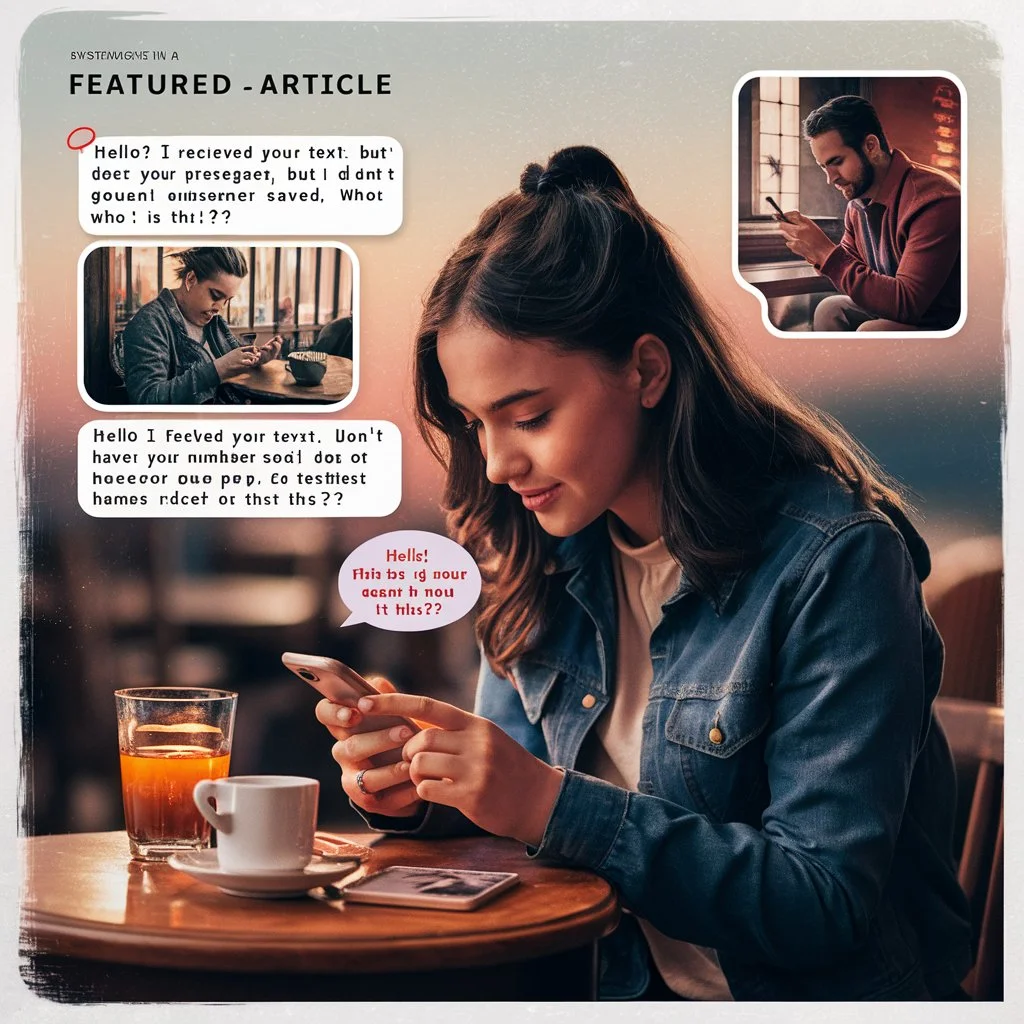Receiving a text from an unknown number can be a bit unsettling. Whether it’s a new acquaintance you forgot to save, a long-lost friend, or even a potential scam, knowing how to respond is crucial. In this article, we’ll dive into 30 creative replies that will help you handle these situations with ease. With a mix of politeness, curiosity, and clarity, you’ll never be left wondering who’s on the other end of the line. Let’s explore these smart and effective responses that ensure you identify the sender every time.
“Sure, but who are you again?” – Never Fail To Identify The Sender

Sometimes, the simplest approach is the best. By saying, “Sure, but who are you again?”, you strike a balance between being direct and maintaining a conversational tone. This phrase works well in casual settings, especially when you vaguely remember the context but can’t place the person.
Casual Conversations Made Easy
Imagine you get a message saying, “Hey, it was great catching up last night!” but you have no idea who it’s from. Responding with “Sure, but who are you again?“ keeps the conversation light and opens the door for the sender to reintroduce themselves without feeling awkward.
Maintaining Politeness
It’s important to remain polite while still being clear. This response is perfect because it avoids sounding accusatory or harsh. The sender will understand that you might have simply forgotten and will likely provide the context you need.
“Hey, I’m not sure I have this number saved. Who is this?” – A Polite Inquiry
When you’re unsure who the sender is, it’s best to ask directly but politely. “Hey, I’m not sure I have this number saved. Who is this?” is a great way to inquire without sounding rude.
Establishing Context
This approach is especially useful in professional settings or with acquaintances. By acknowledging that you might not have saved their number, you give the sender a chance to introduce themselves again, making the situation less awkward.
Showing Consideration
This response shows that you care enough to find out who they are, rather than ignoring the message. It’s a courteous way to ensure you’re communicating with the right person.
“Do you mind reminding me who you are?” – Smooth Way To Unveil The Mystery
Sometimes, a softer approach is necessary. Asking, “Do you mind reminding me who you are?” is a gentle way to get the information you need.
Easing Into The Conversation
This phrase works well when you want to be extra considerate of the sender’s feelings. It shows that you’re open to continuing the conversation once you know who you’re talking to.
Reducing Awkwardness
By phrasing it as a request, you reduce the potential awkwardness for both parties. The sender will likely appreciate your polite tone and respond accordingly.
“I don’t recognize this number. Can you tell me who this is?” – Clear and Direct
For those times when you need to be straightforward, “I don’t recognize this number. Can you tell me who this is?” is a clear and direct way to ask for the sender’s identity.
Cutting to the Chase
This response is perfect for situations where you don’t have the time or patience for subtlety. It gets straight to the point and lets the sender know exactly what you need.
Professional Settings
In professional settings, being clear and direct is often the best approach. This response ensures that there’s no confusion and helps you quickly identify who you’re dealing with.
“Hi, could you please remind me where we met?” – Prompt For Context
When you have a vague idea of who might be texting but need more context, “Hi, could you please remind me where we met?” is a perfect question.
Triggering Memory
This response encourages the sender to provide more details, which can trigger your memory and help you place them. It’s a respectful way to ask for more information.
Keeping It Light
Keeping the tone light and friendly, this approach works well in both personal and professional settings. It shows that you’re interested in making a connection but need a little help remembering.
“I’m sorry, but your number isn’t saved in my phone. Who am I speaking with?”
Apologizing upfront can soften the request for identification. “I’m sorry, but your number isn’t saved in my phone. Who am I speaking with?” is a considerate way to ask for more information.
Expressing Regret
By expressing regret, you show the sender that you’re aware of the potential inconvenience. This can make them more willing to reintroduce themselves.
Professional Courtesy
This response is particularly useful in professional settings where maintaining a polite demeanor is crucial. It’s a respectful way to ask for clarification without sounding dismissive.
“Hey there! I don’t have your number saved. Who’s texting?” – Friendly Approach
A friendly and casual tone can go a long way in easing the conversation. “Hey there! I don’t have your number saved. Who’s texting?” is a great way to keep things light.
Building Rapport
This response helps build rapport with the sender by using a cheerful and inviting tone. It’s perfect for casual conversations where you want to come across as approachable.
Encouraging Openness
A friendly approach encourages the sender to be open and provide the information you need. It sets a positive tone for the rest of the conversation.
“Hello! I received your text, but I don’t have your number saved. Who is this?”

When you want to be polite yet straightforward, “Hello! I received your text, but I don’t have your number saved. Who is this?” is an excellent choice.
Clear Communication
This response clearly communicates that you need the sender to identify themselves. It’s direct but still polite, making it suitable for various contexts.
Professional and Personal Use
Whether in a professional or personal setting, this response works well. It strikes a balance between being courteous and getting straight to the point.
“Hi, I think I might have lost your contact. Could you remind me who this is?”
Admitting that you might have lost their contact is a humble way to ask for identification. “Hi, I think I might have lost your contact. Could you remind me who this is?” shows humility and honesty.
Admitting Mistakes
Admitting that you might have lost their contact can make the sender more understanding. It shows that you’re human and can make mistakes, which can foster a sense of empathy.
Encouraging a Response
This approach encourages the sender to help you out by providing the information you need. It’s a respectful and humble way to ask for their identity.
“Hey! Your number isn’t saved on my phone. Can you tell me who you are?”

Sometimes, a straightforward yet friendly approach is best. “Hey! Your number isn’t saved on my phone. Can you tell me who you are?” is a perfect example.
Blending Friendliness with Directness
This response blends friendliness with directness, making it suitable for various situations. It’s approachable and clear, ensuring you get the information you need without causing any discomfort.
Versatile Usage
Whether you’re dealing with a friend, acquaintance, or professional contact, this response works well. It’s versatile and effective in different contexts.
“Hi! Your message came through, but I don’t have your number saved. Who’s this?”
For a polite and clear inquiry, “Hi! Your message came through, but I don’t have your number saved. Who’s this?” is an ideal choice.
Polite Inquiry
This response is polite and respectful, making it suitable for all kinds of conversations. It shows that you’re interested in knowing who the sender is without being overly direct.
Maintaining Respect
Respect is crucial in any conversation, and this response ensures you maintain it. It’s a great way to ask for the sender’s identity without coming across as rude or dismissive.
“Sorry, I don’t recognize this number. Can you let me know who you are?”
When you’re unsure who’s texting, a direct but polite response is often best. Saying, “Sorry, I don’t recognize this number. Can you let me know who you are?” strikes a balance between clarity and courtesy.
Clear Communication
This response leaves no room for ambiguity. It clearly conveys that you don’t recognize the number and need the sender to identify themselves. This direct approach is useful in both personal and professional settings where clear communication is essential.
Politeness and Respect
Despite its directness, this response remains polite. By starting with “sorry,” you soften the request and show that you respect the sender’s feelings. This balance of directness and politeness makes it an effective way to inquire about the sender’s identity.
“Hey, I don’t have your number saved. Could you remind me who this is?”
A friendly and polite tone can make all the difference. Responding with, “Hey, I don’t have your number saved. Could you remind me who this is?” keeps the conversation light and approachable.
Friendly Inquiry
This response is friendly and non-confrontational, making it perfect for casual conversations. By acknowledging that you don’t have their number saved, you give the sender a chance to reintroduce themselves without feeling awkward.
Encouraging Openness
Using a friendly tone encourages the sender to be open and forthcoming with their identity. This approach is particularly useful in personal settings where maintaining a positive relationship is important.
“Hi! This number isn’t saved in my contacts. May I know who’s texting?”
When you need to be clear yet courteous, “Hi! This number isn’t saved in my contacts. May I know who’s texting?” is an excellent choice. This response is both respectful and direct.
Polite and Professional
This response is suitable for both personal and professional contexts. It’s polite and shows that you’re interested in knowing who the sender is without being overly direct.
Seeking Identification
By asking “May I know who’s texting?” you show that you’re politely seeking identification. This respectful approach ensures that the sender feels comfortable providing their details.
“Hey, could you remind me who you are? I don’t have your number saved.”
Sometimes, a straightforward request for a reminder is the best approach. Saying, “Hey, could you remind me who you are? I don’t have your number saved,” is both clear and considerate.
Honest and Direct
This response is honest and direct, making it clear that you don’t have the sender’s number saved. It’s an effective way to ask for their identity without causing any discomfort.
Maintaining Courtesy
Despite its directness, this response remains courteous. By asking for a reminder, you show that you’re open to continuing the conversation once you know who you’re speaking with.
“I received your text, but I don’t have your number saved. Who am I speaking with?”
When clarity is key, “I received your text, but I don’t have your number saved. Who am I speaking with?” is a great way to ensure you get the information you need.
Professional Clarity
This response is particularly useful in professional settings where clear communication is essential. It ensures that you know exactly who you’re dealing with, which is crucial for maintaining professionalism.
Courteous Inquiry
By framing it as an inquiry, this response remains courteous. It shows that you’re interested in knowing who the sender is without sounding dismissive or rude.
“Hi, this number isn’t familiar. Could you remind me who you are?”
When you need to be polite and clear, “Hi, this number isn’t familiar. Could you remind me who you are?” is a perfect choice. This response is both respectful and direct.
Polite Request
This response is a polite way to ask for the sender’s identity. It shows that you’re interested in knowing who they are without being overly direct.
Seeking Clarity
By asking for a reminder, you’re seeking clarity without causing any discomfort. This approach is useful in both personal and professional settings where maintaining a positive relationship is important.
“Hello! I don’t recognize your number. Could you please tell me who this is?”
For a polite and clear inquiry, “Hello! I don’t recognize your number. Could you please tell me who this is?” is an ideal choice. This response is respectful and straightforward.
Clear and Courteous
This response is both clear and courteous, making it suitable for all kinds of conversations. It shows that you’re interested in knowing who the sender is without being overly direct.
Maintaining Respect
Respect is crucial in any conversation, and this response ensures you maintain it. It’s a great way to ask for the sender’s identity without coming across as rude or dismissive.
“Hey, I received your message but don’t have your number saved. Who’s this?”
When you need to be straightforward yet friendly, “Hey, I received your message but don’t have your number saved. Who’s this?” is a perfect example.
Friendly and Direct
This response blends friendliness with directness, making it suitable for various situations. It’s approachable and clear, ensuring you get the information you need without causing any discomfort.
Versatile Usage
Whether you’re dealing with a friend, acquaintance, or professional contact, this response works well. It’s versatile and effective in different contexts.
“Hi! Your number isn’t in my contacts. Could you tell me who this is?”
When you need to be polite yet straightforward, “Hi! Your number isn’t in my contacts. Could you tell me who this is?” is an excellent choice.
Polite Inquiry
This response is polite and respectful, making it suitable for all kinds of conversations. It shows that you’re interested in knowing who the sender is without being overly direct.
Maintaining Respect
Respect is crucial in any conversation, and this response ensures you maintain it. It’s a great way to ask for the sender’s identity without coming across as rude or dismissive.
“Sorry, I don’t have your number saved. Can you remind me who this is?”

A polite apology can go a long way in softening your request for identification. Saying, “Sorry, I don’t have your number saved. Can you remind me who this is?” shows consideration and respect.
Apologetic Tone
Starting with “sorry” helps to soften the request and shows that you’re aware of the potential inconvenience. This can make the sender more willing to reintroduce themselves.
Seeking Clarity
This response clearly communicates that you need the sender to identify themselves while remaining polite. It’s a respectful way to ask for clarification without sounding dismissive.
“Hello! I received your text but don’t recognize the number. Who am I speaking with?”
For a polite and clear inquiry, “Hello! I received your text but don’t recognize the number. Who am I speaking with?” is an ideal choice. This response is both respectful and direct.
Clear and Courteous
This response is both clear and courteous, making it suitable for all kinds of conversations. It shows that you’re interested in knowing who the sender is without being overly direct.
Maintaining Respect
Respect is crucial in any conversation, and this response ensures you maintain it. It’s a great way to ask for the sender’s identity without coming across as rude or dismissive.
“Hey, I don’t have your number saved. Can you tell me who this is?”
Sometimes, a straightforward yet friendly approach is best. “Hey, I don’t have your number saved. Can you tell me who this is?” is a perfect example.
Friendly and Direct
This response blends friendliness with directness, making it suitable for various situations. It’s approachable and clear, ensuring you get the information you need without causing any discomfort.
Versatile Usage
Whether you’re dealing with a friend, acquaintance, or professional contact, this response works well. It’s versatile and effective in different contexts.
“Hi! Your message came through, but your number isn’t saved. Who’s this?”
When you need to be polite yet straightforward, “Hi! Your message came through, but your number isn’t saved. Who’s this?” is an excellent choice.
Polite Inquiry
This response is polite and respectful, making it suitable for all kinds of conversations. It shows that you’re interested in knowing who the sender is without being overly direct.
Maintaining Respect
Respect is crucial in any conversation, and this response ensures you maintain it. It’s a great way to ask for the sender’s identity without coming across as rude or dismissive.
“Hello! I don’t recognize this number. Can you tell me who you are?”
For a polite and clear inquiry, “Hello! I don’t recognize this number. Can you tell me who you are?” is an ideal choice. This response is respectful and straightforward.
Clear and Courteous
This response is both clear and courteous, making it suitable for all kinds of conversations. It shows that you’re interested in knowing who the sender is without being overly direct.
Maintaining Respect
Respect is crucial in any conversation, and this response ensures you maintain it. It’s a great way to ask for the sender’s identity without coming across as rude or dismissive.
“Hey, could you remind me who you are? Your number isn’t saved on my phone.”
Sometimes, a straightforward request for a reminder is the best approach. Saying, “Hey, could you remind me who you are? Your number isn’t saved on my phone,” is both clear and considerate.
Honest and Direct
This response is honest and direct, making it clear that you don’t have the sender’s number saved. It’s an effective way to ask for their identity without causing any discomfort.
Maintaining Courtesy
Despite its directness, this response remains courteous. By asking for a reminder, you show that you’re open to continuing the conversation once you know who you’re speaking with.
“Hi! This number isn’t saved in my contacts. Could you remind me who this is?”
When you need to be polite and clear, “Hi! This number isn’t saved in my contacts. Could you remind me who this is?” is a perfect choice. This response is both respectful and direct.
Polite Request
This response is a polite way to ask for the sender’s identity. It shows that you’re interested in knowing who they are without being overly direct.
Seeking Clarity
By asking for a reminder, you’re seeking clarity without causing any discomfort. This approach is useful in both personal and professional settings where maintaining a positive relationship is important.
“Sorry, I don’t recognize this number. Can you let me know who you are?”
When you’re unsure who’s texting, a direct but polite response is often best. Saying, “Sorry, I don’t recognize this number. Can you let me know who you are?” strikes a balance between clarity and courtesy.
Clear Communication
This response leaves no room for ambiguity. It clearly conveys that you don’t recognize the number and need the sender to identify themselves. This direct approach is useful in both personal and professional settings where clear communication is essential.
Politeness and Respect
Despite its directness, this response remains polite. By starting with “sorry,” you soften the request and show that you respect the sender’s feelings. This balance of directness and politeness makes it an effective way to inquire about the sender’s identity.
“Hey, I received your text but don’t have your number saved. Who’s this?”
When you need to be straightforward yet friendly, “Hey, I received your text but don’t have your number saved. Who’s this?” is a perfect example.
Friendly and Direct
This response blends friendliness with directness, making it suitable for various situations. It’s approachable and clear, ensuring you get the information you need without causing any discomfort.
Versatile Usage
Whether you’re dealing with a friend, acquaintance, or professional contact, this response works well. It’s versatile and effective in different contexts.
“Hi! I received your text but don’t recognize the number. Who am I speaking with?”
For a polite and clear inquiry, “Hi! I received your text but don’t recognize the number. Who am I speaking with?” is an ideal choice. This response is both respectful and direct.
Clear and Courteous
This response is both clear and courteous, making it suitable for all kinds of conversations. It shows that you’re interested in knowing who the sender is without being overly direct.
Maintaining Respect
Respect is crucial in any conversation, and this response ensures you maintain it. It’s a great way to ask for the sender’s identity without coming across as rude or dismissive.
“Hey, I don’t have your number saved. Can you remind me who this is?”
Sometimes, a straightforward request for a reminder is the best approach. Saying, “Hey, I don’t have your number saved. Can you remind me who this is?” is both clear and considerate.
Honest and Direct
This response is honest and direct, making it clear that you don’t have the sender’s number saved. It’s an effective way to ask for their identity without causing any discomfort.
Maintaining Courtesy
Despite its directness, this response remains courteous. By asking for a reminder, you show that you’re open to continuing the conversation once you know who you’re speaking with.
“Hi, this number isn’t familiar. Could you remind me who you are?”
When you need to be polite and clear, “Hi, this number isn’t familiar. Could you remind me who you are?” is a perfect choice. This response is both respectful and direct.
Polite Request
This response is a polite way to ask for the sender’s identity. It shows that you’re interested in knowing who they are without being overly direct.
Seeking Clarity
By asking for a reminder, you’re seeking clarity without causing any discomfort. This approach is useful in both personal and professional settings where maintaining a positive relationship is important.
“Hello! Your number isn’t in my contacts. Could you tell me who this is?”

When you need to be polite yet straightforward, “Hello! Your number isn’t in my contacts. Could you tell me who this is?” is an excellent choice.
Polite Inquiry
This response is polite and respectful, making it suitable for all kinds of conversations. It shows that you’re interested in knowing who the sender is without being overly direct.
Maintaining Respect
Respect is crucial in any conversation, and this response ensures you maintain it. It’s a great way to ask for the sender’s identity without coming across as rude or dismissive.
“Hey, I don’t have your number saved. Could you remind me who this is?”
Sometimes, a straightforward request for a reminder is the best approach. Saying, “Hey, I don’t have your number saved. Could you remind me who this is?” is both clear and considerate.
Honest and Direct
This response is honest and direct, making it clear that you don’t have the sender’s number saved. It’s an effective way to ask for their identity without causing any discomfort.
Maintaining Courtesy
Despite its directness, this response remains courteous. By asking for a reminder, you show that you’re open to continuing the conversation once you know who you’re speaking with.
“Hi! Your message came through, but your number isn’t saved. Who’s this?”
When you need to be polite yet straightforward, “Hi! Your message came through, but your number isn’t saved. Who’s this?” is an excellent choice.
Polite Inquiry
This response is polite and respectful, making it suitable for all kinds of conversations. It shows that you’re interested in knowing who the sender is without being overly direct.
Maintaining Respect
Respect is crucial in any conversation, and this response ensures you maintain it. It’s a great way to ask for the sender’s identity without coming across as rude or dismissive.
Conclusion
Receiving a text from an unknown number can be confusing, but with these creative replies, you can easily identify the sender without any awkwardness. Whether you prefer a direct approach or a friendly inquiry, there’s a response here to suit every situation. So next time you get a message from an unfamiliar number, you’ll know exactly how to respond!

Matthew Porter is the visionary behind ReplySwift.com. With a talent for crafting concise and impactful responses, Matthew helps others communicate with clarity and confidence. On ReplySwift.com, he provides expert advice, practical templates, and valuable insights to enhance every reply. Join Matthew and transform your communication skills to make each response swift and effective.












